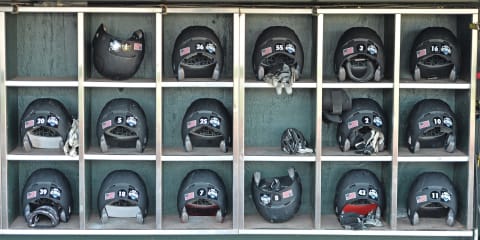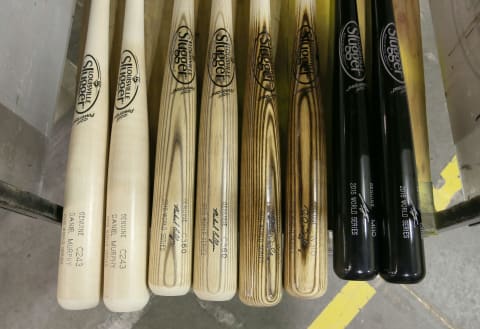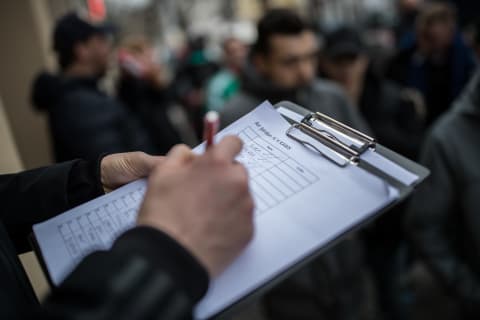Atlanta Braves minors: End of season recap for the 2019 Rome Braves


An end-of-season recap covering all seven Atlanta Braves minor league teams from the 2019 season: Rome Braves.
In this series I will cover each of the seven Atlanta Braves minor league levels, evaluating each club and its top performers.
If you’re interested in jumping to previous recaps:
We’ve made it to the Atlanta Braves full-season minor league clubs, where we’ll start to assess some of the organization’s most prized talent. Today we’ll start with the Atlanta Braves Single-A team, the Rome Braves, who finished their 2019 season on September 2.
The team
The Rome Braves finished with an overall record of 65-74, stemming from a 30-39 first-half record and a 35-35 second-half finish.
The team’s improvements in the second half of the season (especially in the early going) put them in the playoff hunt for a bit, but middling play at the end of the season resulted in a 4th-place finish in the Southern division of the South Atlantic League.
Rome finished as an interesting team on offense, wielding a lineup that had no problem racking up hits (1st in the league) and scoring runs (4th), but finished with the lowest team-home run total in the 14-team league:
Carrying a team-batting average of .249 (3rd), Rome finished in the top-5 in all three slash-stats, getting on base at a .326 clip (t-2nd) and slugging .361 (5th).
Like the offense, Rome’s pitching featured some extreme characteristics.
The team’s pitching staff finished with the 4th-lowest ERA (3.38) and home runs allowed total (77), but was dead-last in strikeouts, finishing with 1,048 punch outs (7.93 K/9) — 83 fewer than the next best team.
Rome was average in terms of walks (7th), sporting a walk-rate of 3.22 BB/9 as a team, or 426 free passes in 1,188.2 innings-pitched.
After covering the Atlanta Braves rookie clubs, we’ve seen some high unearned-run totals, but Rome takes the cake so far, having allowed 113 unearned runs during the 2019 season. I don’t remember Rome’s defense being noticeably bad, but the numbers don’t lie.
- 3B, Brendan Venter: 9 errors (.932 FLD%)
- SS, Carlos Paraguate: 14 errors (.954 FLD%)
- LF, Jeremy Fernandez: 7 errors (.938 FLD%)
These numbers are for the position listed specifically. These players played other positions as well.
For reference, the Atlanta Braves are sitting at +66 in terms of unearned runs over earned runs (through Sunday, Sept. 8).

The top performers
Home runs were hard to come by in the South Atlantic League in 2019 (1,348 HRs in 2018 compared to 1,266 this season) and no team struggled more than Rome.
First baseman Griffin Benson led the team with 13 homers in 2019 — four more than the next guy, second baseman Greg Cullen.
If you’re the manager, though, you’d much rather have Cullen’s numbers, as the 22-year-old slashed .270/.393/.401 with 9 long balls, 6 triples, and 23 doubles — the latter a team-high.
Meanwhile, the power-hitting Benson hit just .208 and struck out 147 times (team-high), good for a whopping 39.2 K%. It was all or nothing for the 21-year-old from Texas.
Though he didn’t play with the team all season, Trey Harris led the team with his .366 batting average. Harris played enough games (56) in Rome to earn a spot in this recap, if not only for the fact that he managed to finish fourth on the team in hits (74) while playing half as many games as the three hitters above him.
The Missouri product slugged 8 homers and 14 doubles before the organization’s decision-makers FINALLY saw enough and moved him up to Florida. Harris played 56 games in Rome, but probably deserved a promotion after Game 20.
The Atlanta Braves first and second picks in the 2019 draft also had respectable stints in Rome.
Shortstop Braden Shewmake debuted with the Single-A team and played 51 games there before jumping over High-A and going straight to Mississippi for the remainder of 2019.
Shewmake hit a solid .318 with 3 homers and 19 doubles during his stretch with Rome, plenty good enough for his first taste of pro ball.
Catcher Shea Langeliers had a rough start to professional baseball, but ended up with a respectable slash-line (.255/.310/.343), as he spent his entire 2019 season with Rome, playing in 54 games.
The player that performed the best and provided the most all-around production was center fielder Justin Dean.
Leading the team in stolen bases with 47 swiped bags (32 more than the player with the second-most), Dean hit .284 and finished the season with 9 home runs. The 22-year-old also led the team with 9 triples, while also finishing tied for the 4th-most doubles (18).
In his 109 total games in 2019, Dean played all but three at center field, where he totaled 14 assists and only 3 errors (.988 FLD%).
Remember, Dean will be representing the Atlanta Braves organization this fall when he plays in this year’s Arizona Fall League.
Rome only had two pitchers break the century mark in strikeouts in 2019, starting pitchers Alan Rangel and Odalvi Javier.
Rangel led the team with 121 punch outs, finishing with a 4.51 ERA and a 10-7 record in 131.2 innings-pitched. This is year three for Rangel in Rome and he’s still hovering around a 4-plus ERA as a pitcher in Single-A, though he did increase his K-rate from 7.5 to 8.3 since 2018.
Twenty-nineteen was Javier’s second season in Rome, and after lowering his ERA by 0.36 points in 22 starts, he earned a promotion to Florida. During his 121.1 innings in Single-A, the 23-year-old carried a 3.78 ERA while striking out 7.5 batters per nine.
Relievers Victor Vodnik and Tanner Lawson had great 2019 seasons. Vodnik is just 19-years-old but is already a strikeout specialist.
Vodnik, the former 14th round pick in 2018’s draft, averaged 17.4 strikeouts per nine in his first season of pro ball last year. In 2019, Vodnik held a more realistic rate, finishing the season with 9.2 K/9 in 23 relief appearances (67.1 IP), while also carrying a 2.94 ERA.
Lawson was a consistent bullpen arm for Rome in 2019, appearing in 30 games as a reliever and striking out 8.7 per nine in 67.1 innings pitched. He ended 2019 allowing just 3 home runs all year, good for a 2.14 ERA in his age-22 season.

The verdict
Now that we’re in full-season ball, a lot of 2019’s top performers are a bit easier to project. The low-minors is still far off from the pitching and hitting of Double-A and Triple-A, but at least most players have matured rather well and are in their early twenties by now.
Several of the players I mentioned are already ranked as Atlanta Braves prospects, with Langeliers listed as the highest-ranked Rome player at No. 8 on FanGraphs THE BOARD.
I think it’s still a bit too early to really determine anything with Langeliers yet, but I like how he bounced back from a pretty terrible start to the season.
If he can even just maintain his .250-ish average and pop a few home runs each season, he’ll be a major league catcher — his defense is already reported to be elite.
Shewmake (#10 at FG) was raking in Rome, then hit a wall once in Mississippi (.218 BA in 14 games). But I don’t need to tell you how meaningless 14 games is — we’re talking 46 at-bats.
Being that both Langeliers and Shewmake were college players and first-round picks, I think it’s safe to expect big things from both.
Harris (#24) is, of course, another Atlanta Braves prospect that appears to have a nice future. He’s done nothing but hit since joining the organization in 2018 as a 32nd round pick by the Atlanta Braves.
In 184 total minor league games, the former University of Missouri player has slashed .317/.395/.480 (.874 OPS) with 15 home runs, 44 doubles, and 9 triples, plus 102 RBI.
And while even successful college hitters can a lot of times go through spurts of poor plate discipline when first beginning pro ball, Harris has been excellent so far: In 659 total pro at-bats, the outfielder has a 17.7 K% and 9.7 BB%.
I’m not claiming he’s the next Ronald Acuna Jr., but I’m betting on an even bigger 2020 season for Harris. At 23-years-old, don’t be surprised if he’s in Gwinnett at some point next season (he played his last 41 games with Mississippi in ’19).
Vodnik (#15) is another 2019 Rome player that I’m high on. I’ve already noted his stats from the last two seasons. But this 14th rounder from California is the real deal.
Vodnik isn’t big — 5’11”, 180 lbs. — but he’s athletic, most likely coming from the fact that he played shortstop in high school.
This guy is all about arm strength, as Vodnik hangs out around the mid-90s MPH and can pump it up into the high-90s with his fastball. The rightie’s best offering is his heater, along with a changeup — currently his best secondary pitch. Vodnik also has a slider that he throws in the mid to high-80s MPH, though he’s still developing it.
Vodnik has put up some impressive numbers during his short career with the Atlanta Braves’ organization. In 27 career appearances, the 19-year-old has a 3.38 ERA while striking out 9.8 batters per nine and walking 3.1 per nine. In 72 total innings pitched the guy has allowed just two home runs — he’s 19!
I’m not ready to project Vodnik as the Atlanta Braves next great closer, but I do think he has the talent to become a decent major league relief pitcher. How he does with more seasoning in the lower minors and how he performs once promoted will tell us a lot more about his future.
Rome was more of a stepping stone this season, as most of the Braves’ prospects either graduated from Single-A before the 2019 season or during. But there’s still a couple of players that will most likely be holdovers for the 2020 season.
More from Tomahawk Take
- Atlanta Braves 2023 Preseason Top 30 Prospects List: 16-20
- Braves News: Reacting to Dansby’s departure, Michael Brantley, more
- Atlanta Braves: Best Option at Shortstop Now That Dansby Swanson is Gone
- Atlanta Braves GM Alex Anthopoulos’ views on the offseason so far
- Braves News: Dansby goes to the Cubs, prospect rankings, more
Eighteen-year-old outfielder Michael Harris (#17) is one to watch. Harris made it to Rome in 2019, after starting the season in the GCL:
▪︎ GCL: 31 games, .349 BA, .917 OPS, 11 XBHs
▪︎ Rome: 22 games, .183 BA, .501 OPS, 3 XBHs
Harris is a bit young, but he has a nice opportunity to make some noise as a 19-year-old in Single-A next season (21.5 years-old is average age in Single-A).
Twenty-one-year-old starting pitcher Trey Riley (#28) is another (he’s currently injured). Riley was a 5th round pick out of Oklahoma State in 2018, but he’s struggled mightily as a pro.
In 23 total appearances (9 app. / 14 starts), Riley has pitched to a 7.71 ERA with 7.4 BB/9… yikes! Being that he was such a high pick, this may be his last chance to show the Atlanta Braves organization that he wasn’t a bust.
I expect even more players will stand out and surprise us next season as well. At anytime a young player can figure things out and explode for a big season.
The outlook for Rome in 2020 looks to be similar to 2019. With all of the promotions in ’19, I expect next year’s team to be rather young. We should see numerous players that were selected in this year’s draft, coming up in Rome in 2020 as well.
Either way, it should be a fun season.
Next. Time to panic on Dansby?. dark
Be sure to check back soon. Next up, we’ll recap the 2019 Florida Fire Frogs and its top performers from this season.